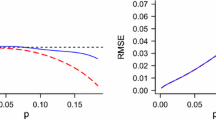Abstract
In multilaboratory clinical studies, laboratory differences cannot be ignored when analyzing data from different laboratories together. In this paper, we propose a new method to transform data across laboratories. The method uses established empirical distributions of assay results from different laboratories for the transformation. This transformation does not rely on either the distributional assumption of the assay reading data or the reference ranges that are required by commonly-used standardization methods. A simulation study shows that the mean and standard deviation of the transformed data are close to the true values. A clinical example is given to compare the usual standardization method to our method. In general, our method is shown to be useful in combining data from multiple laboratories, especially when the data are nonnormal and when the reference ranges are not reliable. Finally, the pros and cons of the method are discussed.
Similar content being viewed by others
References
International Conference on Harmonization. E9. Statistical Principles for Clinical Trials. February 5, 1998. www.ifpma.org/pdfifpma/e9.pdf.
Chuang-Stein C. Summarizing laboratory data with different reference ranges in multi-center clinical trials. Drug Inf J. 1992;26(1):77–84.
Gilbert G, Mosher K, Zubkof L. A procedure for the simplification and assessment of lab parameters in clinical trials. Drug Inf J. 1986;20:279–296.
Gilbert G, Ting N. Statistical comparison of drug safety in controlled clinical trials: the Gene score as an objective measure of lab abnormalities. Drug Inf J. 1991;25:81–96.
Royston P, Mattews JNS. Estimation of reference ranges from normal samples. Stat Med. 1991;10:691–695.
Reed AH, Henry RJ, Mason WB. Influence of statistical method used on the resulting estimate of normal range. Clinical Chemistry. 1971;17(4):275–284.
Brunelle RL, Huang J, Fineberg SE, Anderson JH. Insulin antibody responses with results from insulin lispro in long term studies in patients with type 1 and type 2 diabetes. Diabetologia. 1999;42 (suppl 1): A98.
Brunelle R, Huang J, Zhao Q, Anderson J. Combining insulin antibody data from different laboratories using an empirical cumulative distribution function (CDF) transformation. Diabetes. 1999;48(suppl 1):A430.
Author information
Authors and Affiliations
Rights and permissions
About this article
Cite this article
Huang, J., Brunelle, R. A Nonparametric Method for Combining Multilaboratory Data. Ther Innov Regul Sci 36, 395–406 (2002). https://doi.org/10.1177/009286150203600219
Published:
Issue Date:
DOI: https://doi.org/10.1177/009286150203600219




